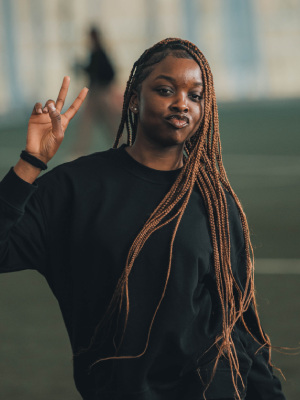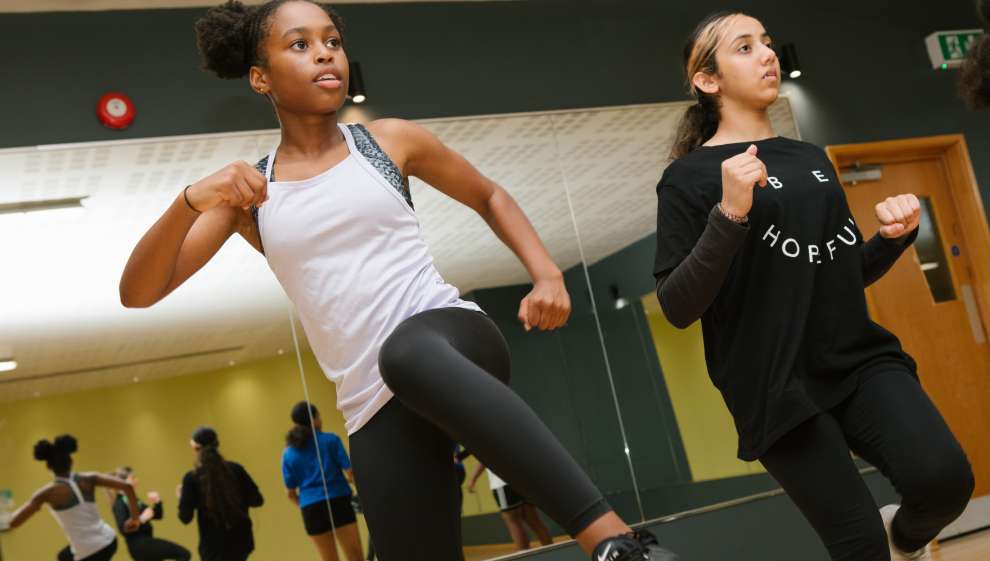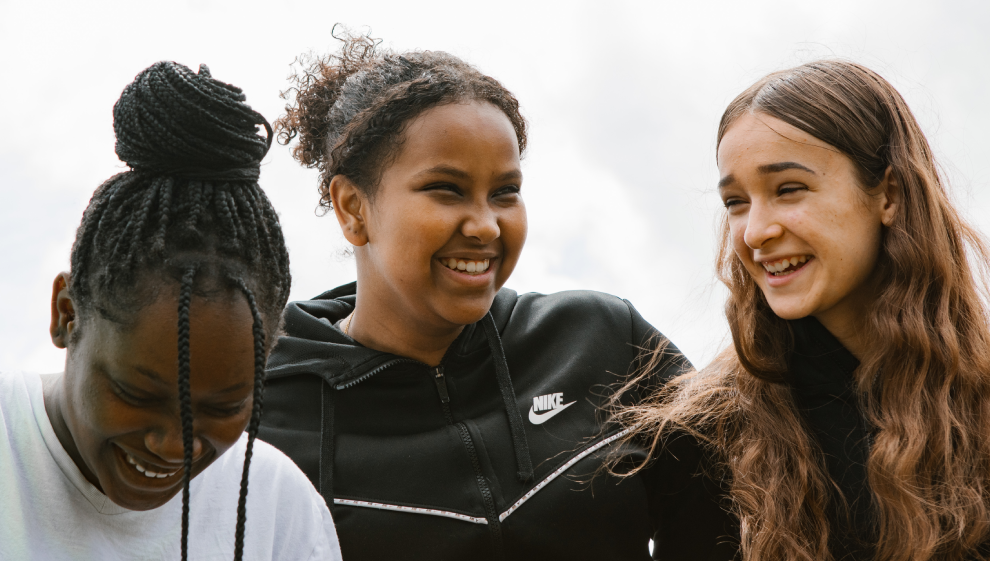The benefits of movement and exercise for teenage girls
We’ve put this list together to help you as parents deal with difficult conversations and communicate the broad range of mental and physical benefits that movement and exercise can have for your daughter.
The mental health benefits
Self-esteem and confidence

Low self-esteem and confidence issues are common in teenage girls. This can stem from comparing themselves to others on social media, feeling insecure about their appearance, or being teased for things outside their control.
As parents, try to support your daughter and validate her feelings. Low self-esteem and a reluctance to engage in exercise often go hand in hand, so emphasise the positives and give reassurance that exercise doesn't need to be intense or vigorous to be beneficial.
Spending more time walking the dog, biking, or playing with younger siblings can make a significant difference in how she feels about herself and her ability.
For everyone, doing things we thought we couldn’t is a great way to improve self-confidence and find out that we’re capable of achieving more than we think.
Overall mood
We know that physical activity is a natural mood booster. When we move, we promote the production of endorphins (feel-good chemicals) that enter our blood and make us feel good.
Unfortunately, stigma, self-conscious thoughts and feelings, and other social barriers make a large percentage of teenage girls feel uncomfortable taking part in physical activity. More young women are avoiding exercise and not carrying it into adulthood because these barriers prevent them exploring it in their teenage years.
As parents, we must remember that teenagers are dealing with a lot of mental and physical changes. They’re also learning ways to process complex emotions and to solve problems on their own. Whilst it can be difficult to initiate the conversation, talking to your child about the benefits of movement and physical activity for their mind and body can help them manage their transition through puberty.
Habits that carry into adulthood
Childhood and our teenage years are where we develop the habits we carry into adulthood.
Unfortunately, teenagers often become apathetic and cynical about certain things, which can make conversations about things they don’t enjoy difficult for parents. The best way to approach this is to start at a young age. Encourage and praise movement and remind your daughter how much fun movement can be.
Encouraging your daughter to develop and maintain a healthy relationship with movement from a young age means they’re more likely to do the same when they reach adulthood. This will decrease her risk of developing conditions and symptoms like high blood pressure, joint pain, and weight-related problems as an adult.
The physical health benefits
Sleep quality
It’s no secret that children need a lot of sleep as they continue to grow. Going through puberty is taxing on the mind and body and has a big impact on a child’s sleep routine and the quality of the rest they get.
As children grow up, they tend to fall asleep later, with teenagers routinely staying up late into the night while their parents are fast asleep.
The NHS currently recommends the following:
- Children between 6 and 13 should aim for around 9 to 12 hours per night
- Children between 13 and 18 should aim for around 8 to 10 hours per night
Engaging in some form of physical activity or movement during the day significantly improves sleep quality in children and teenagers. These activities help them burn off energy and feel tired by the end of the day.
In contrast, children who remain inactive may struggle to fall asleep. We recommend avoiding exercise too close to bedtime, as this can affect your child’s natural circadian rhythm (body clock).
Keeping busy and moving about during the day also means more time in the sun, which is proven to help with sleep quality. When we’re in the sun, our body associates that time with wakefulness, meaning when the sun goes down, we naturally feel sleepy again.
Changes during puberty
Unfortunately, teenage girls are noticeably more inactive than teenage boys. That’s why it’s important to reinforce the benefits of getting up and getting moving, no matter how intense or vigorous the activity is.
Exercise can help manage certain physical and mental changes during puberty. These include:
- Acne
- Anxiety
- Bloating
- Cramps
- Irritated skin
- Mood swings
- Period pain
- Pimples
- Stress
- Weight management
Lots of girls will be exercising without even knowing it, however dedicated periods of moderate to intense exercise can carry added benefits. This includes activities like playing football, attending a Move Together class, gymnastics, cheerleading, or going for a run.
Exercise is also a great way for teenage girls to build confidence in their body as it’s going through intense change. Playing sports and achieving personal goals can help them see their body as capable and powerful during this challenging time.
Skin problems and conditions
Teenage girls often experience skin problems like acne, increased oiliness, and breakouts as their hormones fluctuate during puberty.
More physical activity in your daughter's routine can help her deal with stress and process self-conscious thoughts that may arise if she already has problems with her skin. Faster circulation during exercise can also promote the delivery of oxygen and nutrients to skin cells and accelerate sweating which can help clear out pores and reduce the likelihood of acne and blackheads forming.
Lastly, teenage girls should try and establish a skincare routine if they start experimenting with makeup. Remembering to wash and properly use products that are kind on sensitive skin and appropriate for their age will help prevent their pores from clogging.
Bone and muscle health
You may find that your young girl who was once incredibly active is now spending more time in bed or sitting on the sofa.

This could be down to puberty and rapid growth causing changes to her bone and muscle structure. This can lead to growing pains, poor posture, and an increased risk of injury.
If this sounds familiar, you’re not alone. Do your best to find creative ways to encourage movement and if your daughter regularly complains that she’s tired, let her rest, and try tapping into something she enjoys doing earlier or later in the day. Count every win, no matter how small each one might feel.
Whilst strength training exercises are great for building muscle mass, if performed incorrectly, they can do more harm than good for teenage girls. Weight-bearing activities like running, dancing, and jumping are great for increasing bone density, which can reduce a woman’s risk of osteoporosis later in life.
The bottom line is that encouraging your daughter to incorporate more physical activity can help her navigate changes to her body during puberty and establish lifelong habits that contribute to better health later in life.
The social benefits
Working through the ‘anxiety barrier’
PE lessons and after-school clubs that involve a lot of movement can be difficult for girls who regularly feel anxious about exercising around other people.
Some of the most common thoughts teenage girls have in these settings are:
- “My body looks funny when I move about”
- “Other people are looking at me”
- “I look stupid when I run or jump”
- “I’ve started my period and can’t take part”
- “I’m worried about getting changed in front of other girls”
- “I’m not good enough so I can’t take part”
If your daughter has expressed similar thoughts or feelings, validate and reassure them. Make sure they know that they’re not alone and that everyone feels anxiety and worry from time to time.
While working through this can feel daunting, let them know that these thoughts and feelings don’t have to be a barrier to finding fun ways to get moving. Work towards finding and building these environments that they find safe and included within.
Moving and exercising in a comfortable space can do the world of good and help teenage girls develop confidence and determination which ultimately leaves them feeling more comfortable exercising around others in the future.
Working as a team

Working as a team and learning to listen and identify the needs of others is a huge life skill that teenagers learn at different speeds.
Being part of a team is a great way to simultaneously have fun and develop empathy and understanding for your teammates. Finding her role in something bigger is a great way to help teenage girls learn selflessness and ways of supporting others in challenging times.
Playing a team sport doesn’t have to be about winning and losing either. As a parent, remind her that while winning is great, the benefits of moving around with friends and having fun extend far beyond coming out on top at the end of it all.
Remind her about how important working towards a common goal is, and how sport can help us develop a sense of community and a shared purpose throughout life. Try to highlight how both success and failure as a group builds resilience and determination that will prove invaluable for her as she grows up.
If possible, attend sessions with her and always encourage effort and willingness rather than results and outcomes. Lead by example and share your own experience of how physical activity and playing sports helped you throughout your life.
Last updated Friday 14 June 2024
First published on Friday 14 June 2024

